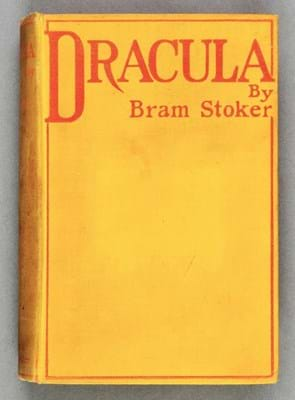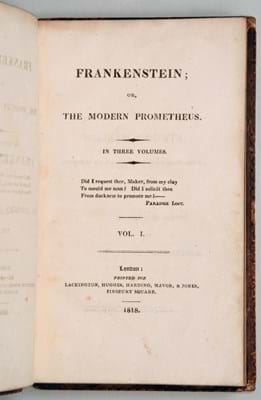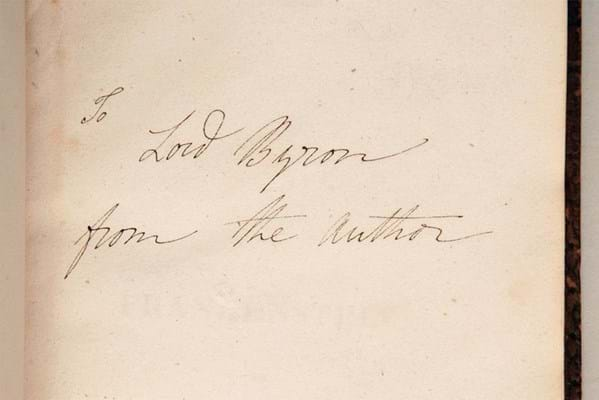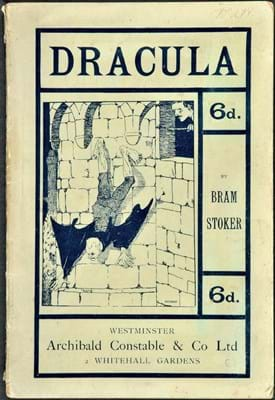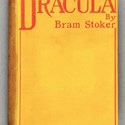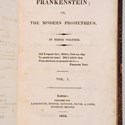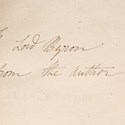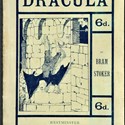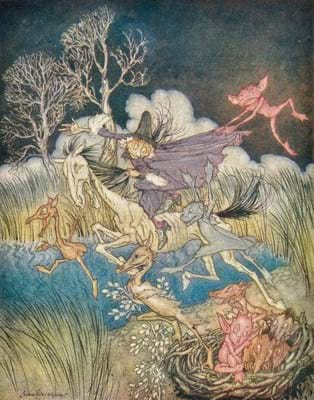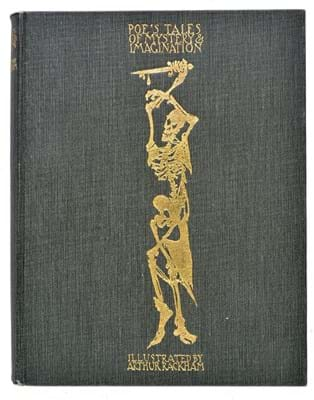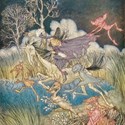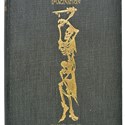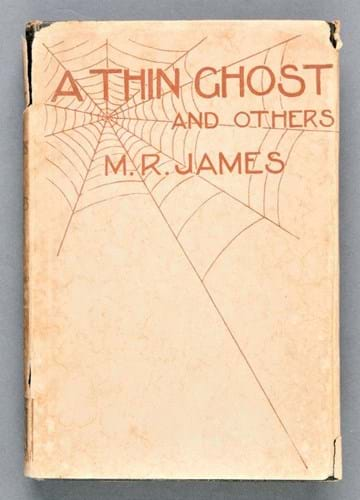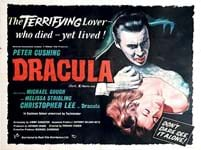Just over 200 years ago, a precociously talented 18-year-old woman had a strange dream while holidaying with friends on the shores of Lake Geneva.
Her dream contained the idea for a “supremely frightful” story which “so possessed my mind, that a thrill of fear ran through me”, she later recalled.
Thus Mary Shelley’s Frankenstein, or The Modern Prometheus, first took shape. This novel, which celebrates its bicentenary this year (it was first published anonymously in 1818), would prove to be one of the most influential works of literature ever written. Unsurprisingly, the first edition is one of the most valuable and sought-after books in the 21st century market.
In 2012, while sorting through the papers of his late grandfather, Douglas, Lord Jay, Sammy Jay discovered to his astonishment a copy carrying a momentous inscription on the flyleaf: “To Lord Byron, from the Author”.
It had been Byron’s suggestion to the Shelleys and fellow Romantic John Polidori, assembled together for that rainy summer in Switzerland, that they should each compose a ghost story.
London dealership Peter Harrington (where Jay now works) sold the book, amid a flurry of international publicity, for an undisclosed six-figure sum to a private collector. It is one of only two editions to be signed by Mary; the other resides in the Pierpoint Morgan Library, New York.
As a literary genre, the Gothic continues to attract strong interest from buyers. The 51st California International Antiquarian Book Fair adopted it as a theme this year to mark the Frankenstein bicentenary and honour a rich and varied tradition of the supernatural, irrationality, sexual obsession, madness, and the sinister potential of science.
This popularity of the genre, and of Frankenstein in particular, owes a good deal to our own 21st century anxieties. Peter Selley, books and manuscripts specialist at Sotheby’s, says: “The Gothic genre taps into our fear of artificial intelligence and whether we’re going to be taken over by robots. Will we create something that will then control us? It is very much of the moment and I think this will drive new interest. The digital age and AI gives it an immediate new focus.”
“The Gothic genre taps into our fear of artificial intelligence”
Gothic literature begins in the late 18th century with Horace Walpole’s The Castle of Otranto (1764) and continues into the 19th century with the work of authors such as Edgar Allan Poe. It re-emerges with tremendous force in many fin-de-siècle novels, such as Robert Louis Stevenson’s The Strange Case of Dr Jekyll and Mr Hyde (1886), Bram Stoker’s Dracula (1897) and Oscar Wilde’s The Picture of Dorian Gray (1890). Other popular 19th century works exist on the edges of the genre, and were profoundly influenced by it – such as Northanger Abbey (1817), Jane Eyre (1847), Wuthering Heights (1847) and Great Expectations (1861).
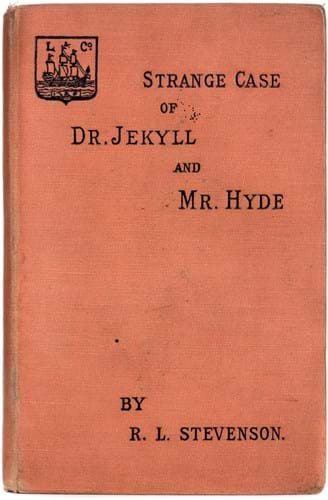
The covers of many 19th century editions of Gothic classics are relatively plain. This first edition of Robert Louis Stevenson’s 'The Strange Case of Dr Jekyll and Mr Hyde' sold for £1200 at Dominic Winter in December 2017.
Movie boost
The fact that so many of these novels have been popularised in recent films and television also contributes to demand, according to Matthew Haley, head of books, maps and manuscripts at Bonhams. “Essentially the works that have the most value are the ones that have been covered time and again by the film industry. They exist in the popular imagination and have crept into our ordinary vocabulary.”
There are many collectors, too, who sincerely love the literature. “In other areas of book collecting, it’s the physical, beautiful object, such as the binding, that is valued. But in this area, I think the interest comes from having read the stories and enjoyed them,” says Susanna Winters, specialist at Dominic Winter auctioneers in Cirencester.
So which works command the highest prices? Frankenstein is a long way ahead of the pack. Aside from that stand-out Peter Harrington sale in 2012, Sotheby’s sold one of the rare first editions (only 500 were printed) in 2010 for £95,000. “There is always great demand for Frankenstein, but copies in less good condition wouldn’t make as much,” says Selley. “If we had the same copy now we’d probably put it in at a £100,000- 150,000 estimate.”
The prices of major works such as Dracula and The Strange Case of Dr Jekyll and Mr Hyde vary widely in price according to condition. An average first edition of Dracula will make a few thousand pounds, but a “very good copy”, bound in the original yellow cloth, sold at Dominic Winter in 2015 for £7400.
The Brontës and Jane Austen are enormously popular authors in the rare books world in their own right, but the strong Gothic elements in their key works lend them an extra piquancy for buyers.
Haley recalls Bonhams’ “standout sale” in 2007 of the three-volume first edition of Wuthering Heights (1847) by Emily Brontë, which went for £95,000 – more than double its expected price.
Signed copies
An author’s signature moves the goalposts again. Robert Ansell, of Lawrences auctioneers in Somerset, sold a first edition of Dracula, inscribed by Bram Stoker, in 2013 for £29,000 – beating its estimate of £8000-10,000 by a long way. Peter Harrington currently has an American first edition, from 1899, inscribed by Stoker, for sale at £25,000. Another signed US first sold at Bonhams New York in 2015 for $11,000 (£9944).
Don’t expect too much in the way of gore. Even though it’s a genre that lends itself wonderfully well to illustration, 19th century editions tend to be quite plain. However, later illustrated 20th century editions are sometimes of note. “Arthur Rackham’s illustrations for Poe’s Tales of Mystery & Imagination are enduringly popular – the cloth binding of the first edition of 1935 has a skeleton in gilt,” says Winters.
Pictorial appeal
Dominic Winter sold an abridged edition of Dracula, from 1901, for £2600 in 2012. “The wrapper is what set the price here,” she says, “as it bears a striking illustration of Count Dracula crawling down the castle wall and is one of the earliest depictions known of the world’s foremost vampire.”
A good modern casing can bump up the value. Selley cites a pictorial slipcase designed by the bookbinder Sangorski & Sutcliffe for a first edition of Dracula, that “very cleverly worked a vampire design into the box. I think that extra visual element helped that copy.” It sold for £12,000 in 2008.
Haley also recalls a flamboyant modern binding of Poe’s Tales of Mystery & Imagination, designed by Susan Allix in 1991 for the bibliophile Denis Collins. It featured a plastic hand holding the skull of a rabbit, a dagger and a quail’s skull. It fetched £1300 in 2016 at Bonhams.
If such prices are beyond the reach of most, it’s worth noting that the works of other influential authors in this genre can still be bought for surprisingly affordable prices. Haley says it’s an area that is rich in potential for the savvy collector and dealer.
“I think there would be great intellectual pleasure, and relatively little cost, to drilling down into original Gothic literature,” he says. “For the cost of one Wuthering Heights you could assemble an incredibly thorough collection of ‘core’ Gothic works.
“The funny thing is that the lesser-known tomes like Horace Walpole’s Castle of Otranto or Thomas Love Peacock’s Nightmare Abbey, which are absolutely seminal in terms of literary history, are pockets of real value – you can pick them up for a few hundred pounds.”
“Walpole’s Castle of Otranto can be bought for a few hundred pounds”
Haley also suggests Gothic novels such as William Beckford’s Vathek (1786) and Matthew Lewis’s The Monk (1796), which, likewise, “can be had for hundreds rather than thousands at auction”.
Selley recommends keeping an eye out for the ghost stories of MR James (1862-1936), which “don’t make a huge amount”, and first editions of 20th century writers, such as Stephen King, Anne Rice and James Hogg, who enjoy a cult following, particularly in the US, but whose prices are quite modest.
However, even first editions of Gothic masterpieces can sometimes be bought for sums that are not prohibitive. Dominic Winter recently handled the sale of the library of the Watership Down author Richard Adams.
It included a first edition of Dr Jekyll and Mr Hyde, of 1886, one of 1250 copies bound in cloth. It fetched £1200 last December.
And, for those who do have some serious money to invest, there is some lovely peripheral material to consider. Peter Harrington currently has a sheaf of Mary Shelley’s letters for sale, 21 in total, priced at £125,000.
It’s a collection full of personal insights into the marvellous mind and fascinating life of the mistress of the Gothic, whose strange story is uncannily relevant to our own times.

